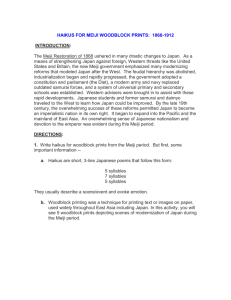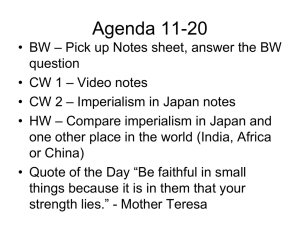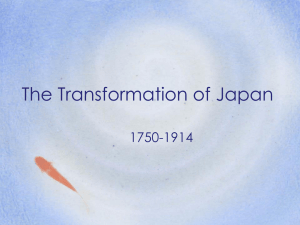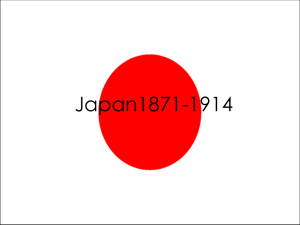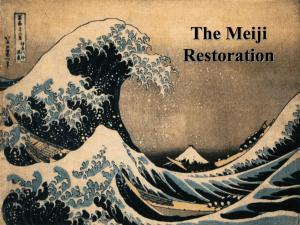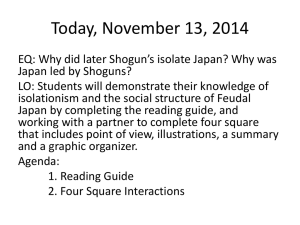Presentation 1 - The Boredom Project
advertisement
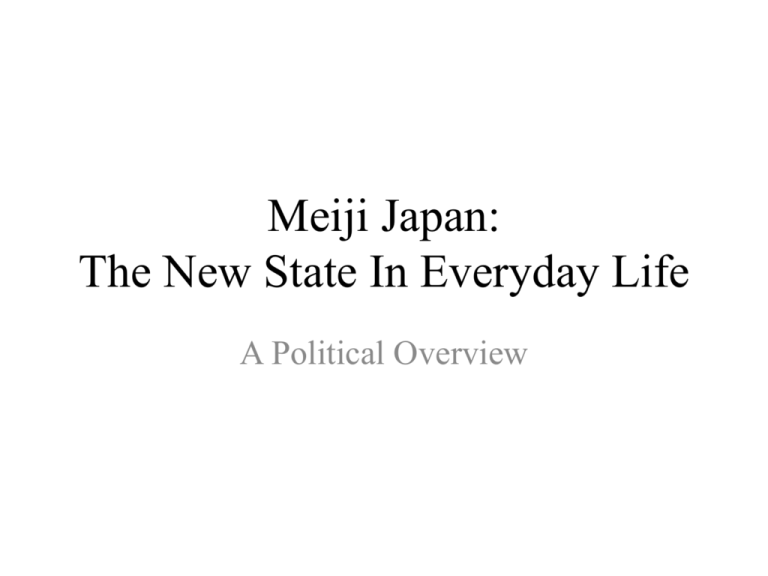
Meiji Japan: The New State In Everyday Life A Political Overview Contents /Roadmap • • • • • • • • • • • • Road Map of key events Five Charter Oath Aftermath Economy The Korean Affair/Seikanron The Satsuma Rebellion Politics: Party and Protest Media Meiji Constitution Military Death of Meiji Brief Historiography Road Map of Key Events • 1868: The Meiji Restoration/ The Five Charter Oath • 1871: Abolition of the han domains, Land / Tax Reforms • 1873: The Conscription Law / Seikanron Debate • 1877: The Satsuma Rebellion / Bank of Japan est. • 1889: Promulgation of the Meiji Constitution • 1894: Sino-Japanese War • 1904-1905: Russo-Japanese War • 1909: (Oppressive) Newspaper Law • 1910: The Annexation of Korea • 1912: The Death of Emperor Meiji The (Five) Charter Oath 7th April 1868 By this oath, we set up as our aim the establishment of the national wealth on a broad basis and the framing of a constitution and laws. 1)Deliberative assemblies shall be widely established and all matters decided by open discussion. 2) All classes, high and low, shall be united in vigorously carrying out the administration of affairs of state. 3) The common people, no less than the civil and military officials, shall all be allowed to pursue their own calling so that there may be no discontent. 4) Evil customs of the past shall be broken off and everything based upon the just laws of Nature. 5)Knowledge shall be sought throughout the world so as to strengthen the foundation of imperial rule. Aftermath of the Restoration Reforms: - Tokugawa Bakufu replaced by oligarchy run by various key officials such as : • Saigo Takamori - One of the samurai leaders of the Satsuma/Choshu forces that overthrew the Bakufu. Later leader of the Satsuma Rebellion • Okubo Toshimichi - A fellow leader in the Satsuma/Choshu forces. • Iwakura Tomomi - A bureaucrat that would become Foreign Minister to America • Ito Hirobumi - student of Yoshida and eventual Prime Minister . - Instigated an emancipation of sorts. - The majority of daimyo surrendered their land along with their census records, but retained their hereditary positions , becoming governors. - The government paid for both the daimyo’s salaries and initially samurai stipends. - The Han were replaced by prefectures in 1871. Economy - Various land and tax reforms were brought in which: • Fairly assessed land for its worth. • Private ownership was legalised. • Tax was to be paid using cash rather than the previous ‘in kind’ method. • Tax rates were decreased. - Capitalist free market model adopted. - Use of O-yatoi gaikokujin ( hired foreigners) to enhance technologies and industries. - Railways built all over Japan. The first stretch of railway, from Tokyo to nearby Yokohama, was completed in 1872, and within 20 years nearly 2,500 kilometers of track had been laid. - Bank of Japan founded in 1877 , used taxation to fund textile and steel industries. - Opening of Japan allowed it to export Silk , which was particularly profitable during the Italian Silk Blight of the late 60s. - The growth of Zaibatsu firms such as Mitsubishi. ( Massive conglomerate firms). - Industrialisation and investment in industries such as coal , steel etc. Initially subsidized by the Meiji government. ( This rapid industrialisation lead to various abuses such as the coal mining facility on Hashima Island) Battleship Island (Hashima Island)! The Korean Affair/ Seikanron - Disagreements between groups within the Meiji Oligarchy regarding the treatment of Korea following its refusal to acknowledge the Emperor Meiji as the legitimate ruler of Japan. - A war with Korea would see many of the out of work samurai employed , and the samurai members of the government such as Saigo Takamori supported such aggressive action. - Takamori offers to travel to Korea and insult their rulers until they kill him in order to provide a sufficient enough excuse. Others in the Oligarchy see this as foolish given that Japan has not modernised sufficiently to resist the Western powers and lacked the budgetary funds. - Takamori resigns his post along with many other samurai within the government. Which leads to complaints from many samurai, the public and the press. ! ! The Resentment of The Samurai - Removal of privileged position and with that income. - The Meiji modernisation seemed to many samurai to conflict with the sonno joi barbarian) sentiment that had driven the overthrow of the bakufu. - In 1873, samurai stipends are taxed and the Conscription law of 1873 saw the samurai lose their privilege of being able to make war. Every male citizen was capable of becoming part of the military. - 1874 the government attempts to appease the disgruntled samurai by offering government bonds in exchange for their stipends. Those who accepted received favourable returns. - By 1876, all of the prerogatives of the samurai had been systematically and incrementally revoked - Many samurai saw the Oligarchy as undemocratic and becoming steadily more repressive. - The Meiji Oligarchy also saw the disaffected samurai as a threat to their authority , which causes them to shame the class further by confiscating their weaponry. - These resentments lead to various rebellions and uprisings, the most notable being the Satsuma Rebellion of 1877. (expel the The Satsuma Rebellion 1877 - - - - - - Battle of Shiroyama Similar to the Saga uprising of 1874 in which disgruntled samurai rise against the Meiji Government. Led by Saigo Takamori and other disgruntled samurai after a supposed attempt on Takamori’s life. Considered the samurai class’ last stand . When government troops march to Satsuma to take the samurai’s weapons from them they revolt with terrible consequences. Decisive victory for the better equipped and trained Meiji forces and Takamori is either killed or commits seppuku. Inspiration for the film 2003 The Last Samurai Politics: Party and Protest Political Parties: - 1882 Rikken Kaishinto, est. 1882 : Constitutional Progressive Party. Looked for a system similar to the British model. - Rikken Teiseito : Imperial Rule Party - 1881 Jiyuto : Liberal Party . Connected with the Freedom and Popular Rights Movement. Other Groups: • The Freedom and Popular Rights Movement: - Demanded an immediate creation of a democratic national assembly. - The Oligarchy on the other hand favoured a gradualist aproach. - Women not permitted to attend meetings. Media - Although prior to the restoration there was a thriving book industry , periodicals were not widely used or encouraged unless reporting suicides or earthquakes. New technology allowed the growth of the media , progressing from the use of woodblocks to proper printing. - The Meiji government distribute Tokyo newspapers free of charge throughout Japan . - Initially open media until events such as the Satsuma Rebellion and the Korean discussion causes nationwide criticism. The 1875 Newspaper Ordinance is issued to counter this. - Disgruntled samurai regularly criticise the government and in the lead up to the promulgation of the Meiji Constitution in 1889 - From 1882 to 1887, 174 periodicals were suspended and 4 banned altogether . - Newspaper Law of 1909 allowed administrators to ban journals from circulation and to seize copies without resorting to prosecution. Historiography • George Akita suggests that - government restraints were modest in proportions • Richard Mitchell sees this censorship as akin to an ‘embryonic Gulag Archipelago’ Meiji Constitution : 1889 After examining and comparing varying constitutions belonging to Western powers including the U.S and British constitutions, Japan settled on one similar to the Prussian model , with supreme sovereignty resting with the Emperor who appointed judges, cabinet members, military generals, consulted with councils etc. Bicameral legislature established , with executive appointed on the Emperor’s behalf. • Duties: The constitution asserts the duty of Japanese subjects to uphold the constitution (preamble), pay taxes (Article 21) and serve in the armed forces if conscripted (Article 20). • Qualified rights included: – Freedom of movement (Article 22). – Not have one's house searched or entered (Article 25). – Privacy of correspondence (Article 26). – Private property (Article 27). – Freedom of speech, assembly and association (Article 29). Less conditional rights – Right to "be appointed to civil or military or any other public offices equally" (Article 19). – 'Procedural' due process (Article 23). – Right to trial before a judge (Article 24). – Freedom of religion (Guaranteed by Article 28 "within limits not prejudicial to peace and order, and not antagonistic to their duties as subjects"). – Right to petition government (Article 30) • Sovereignty remained with the emperor though. Was this a move to prevent further popular involvement in the political development of the Japanese nation? Military - As Japan sought to modernise , it also sought to arm itself against foreign powers. - fukoku kyohei ‘enrich the country, strengthen the military ’ - Conscription law of 1873 meant compulsory three years of military service for men over 20, with some being sent abroad to study. This would upset the samurai and peasant alike. - Various foreign advisers brought in , most of whom were curiously French - A standing and reserve army were created modelled on the French system - Various arsenals are established in Tokyo , Osaka etc. With the aim of producing weaponry , ammunitions and other military technology. - Japan’s first military academy established in Kyoto by Masujiro Omura. ( Assassinated in 1869 after proposing that all classes should be allowed to attend) - Telegraph system sponsored in 1885 - Untested until the Satsuma Rebellion of 1877 , in which the Satsuma samurai that rose against the Meiji forces were soundly beaten culminating in Saigo Takamori committing seppuku in his home. - Sino-Japanese War 1894-95 - Russo-Japanese War 1904-1905 Death of Meiji 1912 • Meiji's death in 1912 is seen as a turning point in modern Japanese history. • By 1912 popular opinion and politics had turned against the military, and sought more participation for more groups in politics. By 1912, leader of the Seiyûkai party, Hara Kei, succeeded in restricting an increase in the military budget. Hara would go on to become Japan’s first commoner, party-based prime minister in 1918. During the same period, unionization and ‘friendly societies’, started to appear • • • • 1911 Factory Act means that the welfare of workers is no longer neglected. • Women remained banned from political meetings until the 1920s Funeral of Meiji Historiography Meiji State • Leftist view: Meiji reforms were oppressive and reactionary (tied in with media) , treatment of women still unfair. • Cullen’s view ( the right): Meiji government was in fact pragmatic , and took the course of action required to prevent it becoming Road Map of Key Events • • • • • • • • • • 1868: The Meiji Restoration/ The Five Charter Oath 1871: Abolition of the han domains, Land / Tax Reforms 1873: The Conscription Law/ Seikanron Debate 1877: The Satsuma Rebellion / Bank of Japan est. 1889: Promulgation of the Meiji Constitution 1894: Sino-Japanese War 1904-1905: Russo-Japanese War 1909: (Oppressive) Newspaper Law 1910: The Annexation of Korea 1912: The Death of Emperor Meiji
